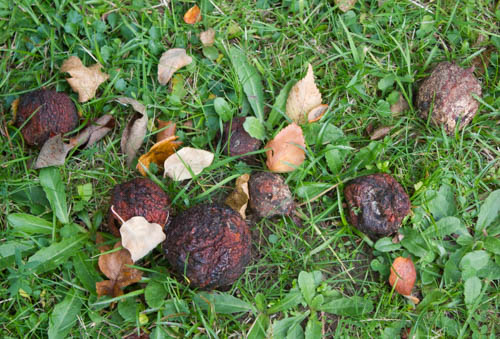Now it is getting chilly, terracotta or glazed pots should be wrapped with several layers of ‘bubble wrap’ or hessian and raised from the ground on bricks or pot feet to stop water-logging and reduce the chances of cracking. They can also be over-wintered in a frost-free glasshouse, at the base of a sheltered wall, under an evergreen hedge covered with leaves, or under evergreen trees. Move ‘Acer’s’ in pots to where they are protected from cold wind and frost and use a sack barrow rather than lifting, to protect your back. Make a tripod of canes over borderline hardiness shrubs, cover them horticultural fleece or frost protection covers and bind the leaves of ‘Cordyline’ together, holding them in place with twine.

Garlic can be planted from early October to late December in light soil on an open sunny site. Incorporate well-rotted organic matter to at least a spades depth and allow to settle before planting, don’t walk on the soil if it is wet. Autumn planting encourages the formation of a good root system before regrowth in spring. Don’t plant until spring, on heavier soils, start them off in pots of loam based compost over winter then transplant outdoors in spring, having dug in grit or planted in ridges to improve drainage. Garlic needs one to two months from 0-10degC (32-50F) to produce decent sized bulbs. Split the bulb on the day, planting with the ’blunt’ end at the bottom and the tip just below the soil to discourage birds from pulling them out. Garlic is classified as ‘hardneck’ or ‘softneck’. ‘Hardneck’s’ are gourmet garlics with fewer larger cloves, but they tend not to store well; most gardeners go for ‘softnecks’, which are not as hardy.
This year’s erratic weather meant that many of my ‘Quince’ fruits split and suffered from brown rot on the tree. The fungus enters through splits caused by birds, codling moth and apple scab damage. Infected fruit that was missed when you were harvesting is easier to see once the leaves have fallen, so pick them off and dispose of in your council green waste bin.
Lightly prune roses, cutting them back by 1/3, they are shallow rooted and tend to rock in the wind, cut your buddleia back in the same way too. Finish pruning next year in late winter or early spring before plants burst into growth.
Keep weeding the borders as weeds continue to grow in in mild weather, cover moist ground with mulch, this not only suppresses weeds but acts as a barrier so winter rain does not compact the surface of poorly formed soils and cause ‘capping’, a hard crust to form on the surface. I also prevents nutrients like nitrogen from washing out of the soil.
Finally, remember to build your bonfire for ‘Guy Fawkes’ night as late as possible to prevent hedgehogs from taking up residence and use the opportunity to burn any diseased plant debris that hasn’t been put in your local authority recycling bin.
Happy Gardening, Matt.










